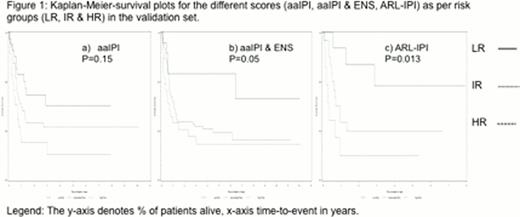Abstract
Abstract 1564
The International Prognostic Index (IPI) and the age-adjusted IPI (aaIPI) are commonly used to predict outcomes in immunocompetent patients with aggressive B-cell Non-Hodgkin Lymphomas (NHL). Although the IPI has also been validated for AIDS-related lymphomas (ARL), HIV-infection is an important competing risk that has not been adequately evaluated as a factor contributing to prognosis in the context of contemporary rituximab-containing chemoimmunotherapy. Here, we assessed whether HIV-specific factors in addition to the IPI provided more accurate prediction of clinical outcomes than IPI alone.
We obtained patient-level data for 487 patients from 8 prospective phase 2 or 3 clinical trials including patients with HIV-associated aggressive B-cell NHL receiving initial therapy with rituximab containing chemoimmunotherapy identified by systematic literature review, and randomly divided the population in a training (N=244) and validation set (N=243). We defined an HIV-score by combining individual HIV risk-factors: (1) baseline CD4 count (cells/ul): <50 =3, 50–199=2, 200–499=1, 500 or more =0; (2) HIV viral load (copies/ml): <400=0; 400-9, 999=1,10,000 or more =2; (3) prior history of AIDS=1, thereby yielding an HIV-score that could range from 0–6. We examined the association of HIV-score in addition to patient-, and lymphoma-specific factors with overall survival (OS) using a Cox-PH-model in the training and validation set independently by comparing 4 different multivariate models by a LR-chi2 test: model 1 (included age, sex, & histology), model 2 (model 1 + aaIPI), model 3 (model 2 + number of involved extranodal disease sites [ENS]) and model 4 (model 3 + HIV-score). Next, we defined a new score (ARL-IPI) by assigning appropriate weights to each significant predictor depending on the strength of association in the multivariate model in the training set: 2 for aaIPI score (0,1,2 or 3); 1 for ENS: no ENS=0, 1 ENS=1, 2 ENS=2, 3 or more ENS=3; and 1 for HIV-score. We examined the difference in OS for 3 risk groups: low (LR), intermediate (IR) and high risk (HR) based on the ARL-IPI in the validation set. We compared the discrimination power of the ARL-IPI with the aaIPI by comparing the difference in OS across the 3 groups defined by each score.
487 patients were included in the analysis with a median follow-up of 2.3 years (0.1–12.1). There were no significant differences in patient characteristics between training and validation set. Considering the entire population, 77% were male, median age was 42 years (20–74), median CD4 count 174 cells/ul (0–2,457), and median HIV viral load 23,802 copies/ml (0–6×106). The histologies included DLBCL (69%), BL or BLL (29%), and other histologies (3%). All patients received rituximab plus either CHOP (49%), EPOCH (19%), CDE (15%), or other multi-agent intensive regimens (16%). In the training set, only aaIPI, ENS and HIV-score were significantly associated with OS, but not age, sex, extranodal sites as defined in the IPI (<2 or 2 or more), or histology. When tested in the validation set, the addition of the HIV-score (model 4; ARL-IPI) showed a significant improvement in predictive power for OS over all other models (p-value=0.009). When we compared the risk groups defined by the aaIPI (LR: <1, IR: 1–2, HR: 3) versus the ARL-IPI (aaIPI + ENS + HIV-score: LR: <7, IR: 7–10, HR: >10) in the validation set, the ARL-IPI was able to more clearly define prognosis based on the 3 risk groups in regards to OS (p=0.013; Table 1), which was confirmed by KM survival analysis (Figure 1). The ARL-IPI also compared favorably to a score defined by aaIPI and ENS (LR: <4, IR: 4–6, HR: >6), demonstrating the significant impact of the HIV-score on prediction power. In our dataset, the ARL-IPI could not significantly improve prediction power for CR rate or PFS compared with the two other scores.
By combining HIV-associated factors with known prognostic patient- and lymphoma factors into a composite prognostic risk score (ARL-IPI) we were able to more accurately define prognosis for patients with ARL treated with chemoimmunotherapy.
Median OS as per risk group adjusted for age, sex & histology in the validation set.
| Risk Group . | 2-year OS % (95%CI) . | ||
|---|---|---|---|
| . | aaIPI . | aaIPI+ENS . | ARL-IPI . |
| Low | 0.83 (0.61–0.93) | 0.75 (0.58–0.85) | 0.87 (0.57–0.97) |
| Intermediate | 0.64 (0.55–0.71) | 0.63 (0.51–0.74) | 0.60 (0.40–0.75) |
| High | 0.60 (0.43–0.74) | 0.55 (0.37–0.70) | 0.50 (0.23–0.72) |
| Risk Group . | 2-year OS % (95%CI) . | ||
|---|---|---|---|
| . | aaIPI . | aaIPI+ENS . | ARL-IPI . |
| Low | 0.83 (0.61–0.93) | 0.75 (0.58–0.85) | 0.87 (0.57–0.97) |
| Intermediate | 0.64 (0.55–0.71) | 0.63 (0.51–0.74) | 0.60 (0.40–0.75) |
| High | 0.60 (0.43–0.74) | 0.55 (0.37–0.70) | 0.50 (0.23–0.72) |
No relevant conflicts of interest to declare.
Author notes
Asterisk with author names denotes non-ASH members.


This feature is available to Subscribers Only
Sign In or Create an Account Close Modal